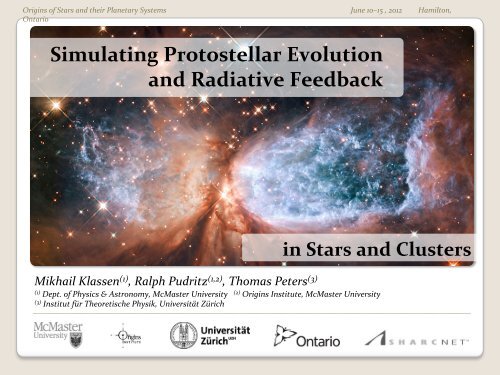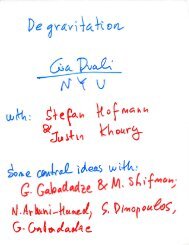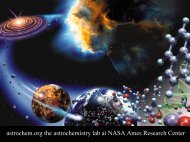PDF of powerpoint presentation - McMaster Origins Institute ...
PDF of powerpoint presentation - McMaster Origins Institute ...
PDF of powerpoint presentation - McMaster Origins Institute ...
You also want an ePaper? Increase the reach of your titles
YUMPU automatically turns print PDFs into web optimized ePapers that Google loves.
<strong>Origins</strong> <strong>of</strong> Stars and their Planetary Systems June 10–15 , 2012 Hamilton, <br />
Ontario <br />
Simulating Protostellar Evolution <br />
and Radiative Feedback <br />
in Stars and Clusters <br />
Mikhail Klassen (1) , Ralph Pudritz (1,2) , Thomas Peters (3) <br />
(1)<br />
Dept. <strong>of</strong> Physics & Astronomy, <strong>McMaster</strong> University (2) <strong>Origins</strong> <strong>Institute</strong>, <strong>McMaster</strong> University <br />
(3)<br />
Institut für Theoretische Physik, Universität Zürich
Massive stars are the “movers and shakers” <strong>of</strong> <br />
the interstellar medium. Their powerful <br />
feedback processes include: <br />
Radiation <br />
Jets and outflows <br />
Stellar winds <br />
HII regions <br />
Supernovae <br />
These phenomena heat gas, inject turbulence, <br />
skew stellar populations, raise galactic <br />
metallicity, and destroy molecular clouds. <br />
HST image <strong>of</strong> compact star forming region Sh 2-‐106. <br />
Credit: NASA & ESA
Massive stars are the “movers and shakers” <strong>of</strong> <br />
the interstellar medium. Their powerful <br />
feedback processes include: <br />
Radiation <br />
Jets and outflows <br />
Stellar winds <br />
HII regions <br />
Supernovae <br />
These phenomena heat gas, inject turbulence, <br />
skew stellar populations, raise galactic <br />
metallicity, and destroy molecular clouds. <br />
HST image <strong>of</strong> compact star forming region Sh 2-‐106. <br />
Credit: NASA & ESA
How do clusters <strong>of</strong> massive protostars shape the dynamics <strong>of</strong> molecular clouds? <br />
How do massive protostars evolve in a turbulent, possibly magnetized <br />
environment? <br />
How does protostellar evolution affect radiative feedback?
Simulating star formation on an adaptive Eulerian mesh <br />
FLASH 2.5
Simulating star formation on an adaptive Eulerian mesh <br />
SINK PARTICLE <br />
Mass <br />
Accretion Rate <br />
PROTOSTELLAR MODEL <br />
Stellar Radius <br />
Luminosity <br />
Deuterium Mass <br />
Evolutionary Stage <br />
Polytropic Index
Protostellar Model based on Offner et al. (2009), solid; compared to <br />
Hosokawa & Omukai (2009) calculations, dashed. <br />
Figures 1 and 2 from Klassen et al. (2012a)
Toy Model: Accretion onto a Single Protostar <br />
Toy model because… <br />
• Gravity turned <strong>of</strong>f <br />
• Spherical symmetry <br />
• Isothermal, homogeneous <br />
initial conditions <br />
Interesting because… <br />
• Connected to protostellar <br />
evolution model <br />
• First calculation <strong>of</strong> HII <br />
region variability due to <br />
variable ionizing source <br />
Low<br />
Mass Density<br />
[ g cm -3 ]<br />
High
Figure 1 from Klassen et al. (2012b, in prep)
HII Region Confined to Protostellar Outflow <br />
Figure 3 from Tan & McKee (2003), IAU Symposium 221, Star Formation at High Angular Resolution
Radiative Feedback in the Cluster Environment <br />
Setup <br />
• 1000 M SUN clump <br />
• r -‐3/2 density pr<strong>of</strong>ile <br />
• Axisymmetric, with <br />
rotation <br />
• One <strong>of</strong> two protostellar <br />
models: <br />
• Peters et al. (2010a) <br />
• Offner et al. (2009)
Note similarity to title slide / HST Image
Mass-‐Radius Relation for a Cluster <strong>of</strong> Protostars <br />
Figure 8 from Klassen et al. (2012a)
Turbulence and MHD <br />
Setup <br />
• 1000 M SUN clump <br />
• r -‐3/2 density pr<strong>of</strong>ile <br />
• Turbulence <br />
(Burger’s spectrum, Mach 5 RMS) <br />
• Uniform B-‐field with <br />
M/Φ ~ 3.5 <br />
Designed to explore <br />
• Impact <strong>of</strong> HII region feedback in <br />
turbulent, magnetized clusters <br />
• Lifetimes <strong>of</strong> MC clumps <br />
1 pc<br />
• Interplay <strong>of</strong> MHD and radiative <br />
feedback
Column Density (g/cm 2 )
Conclusions <br />
• Numerical simulations are illuminating the cluster picture <strong>of</strong> massive star <br />
formation <br />
• Feedback effects are coupled and must be studied individually and in concert <br />
with each other <br />
• Single stars may show variability in their HII regions during their pre-‐main-sequence<br />
evolution <br />
• Clusters are dominated by their most massive stars, with choice <strong>of</strong> prestellar <br />
model having little impact on overall dynamics <br />
• MHD and turbulence may play crucial roles in enhancing radiative feedback <br />
Future Work <br />
• We are combining realistic initial conditions with turbulence, MHD, ionizing <br />
radiation and prestellar modeling to address: <br />
disruption <strong>of</strong> molecular clouds, cloud lifetimes, cluster population dynamics
Thank You <br />
Ralph Pudritz <br />
Thomas Peters <br />
Philipp Girichidis <br />
Daniel Seifried <br />
Elizabeth Tasker <br />
Stella Offner <br />
Mark Krumholz <br />
Takashi Hosokawa <br />
Dennis Duffin
Extra Slides
Figure 2 from Klassen et al. (2012b, in prep) <br />
HII Region Collapsing and Reforming
Mass-‐Luminosity Relation for an Example Protostar <br />
Figure 9 from Klassen et al. (2012a)
Figure 4 from Klassen et al. (2012a) <br />
Mean Ionization and Temperature






